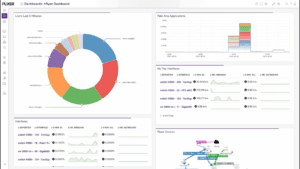Modern networks are sprawling, dynamic ecosystems that power nearly every business function. And to keep these systems running smoothly, organizations need visibility into what’s happening throughout their network. Network monitoring a foundational practice in IT operations, enabling administrators to detect performance degradation, identify device failures, and ensure uptime across both on-premises and cloud environments.
As this article will discuss, however, network monitoring often falls short of the requirements of today’s complex networks.
What is Network Monitoring?
At its core, network monitoring is about knowing what’s happening on your network. It provides real-time visibility into devices, services, and traffic flows to ensure everything stays up and running.
Monitoring covers a broad range of components: routers, switches, firewalls, cloud instances, virtual machines, and more. These systems are constantly polled or observed for availability, performance, and anomalies. The goal is simple: detect and fix problems before users are affected
In practical terms, monitoring allows IT teams to:
- Pinpoint network slowdowns or outages
- Track bandwidth usage and application performance
- Receive alerts when devices go offline
- Analyze trends to support capacity planning
Organizations that monitor their networks effectively experience fewer outages, faster incident response, and greater operational stability.
Metrics That Matter
Not all data is equally valuable. The effectiveness of a monitoring strategy depends heavily on choosing the right metrics to track.
Latency and packet loss, for example, directly affect application performance. High latency degrades user experience, especially in real-time applications like VoIP or video conferencing. Packet loss leads to data retransmission and delays.
Throughput and bandwidth utilization indicate how well the network handles traffic volume. When utilization nears capacity, congestion and bottlenecks are likely.
On the infrastructure side, metrics like CPU and memory usage help identify overloaded devices. These indicators often surface early in performance degradation or failure scenarios.
Some organizations also track jitter (variability in delay), round-trip time (total time to send and receive data), and server response time. Together, these metrics form a baseline for identifying abnormal conditions.
How Monitoring Works
Monitoring isn’t a single process but rather a set of complementary techniques. Three dominant methods are used today:
Active monitoring injects synthetic traffic into the network to simulate user behavior. By testing logins, page loads, or transactions, teams can catch issues before real users do.
Passive monitoring, in contrast, listens to actual network traffic. It collects data through SNMP traps, NetFlow, Syslog messages, and span ports to assess real-world performance and user activity.
Streaming telemetry is the most modern approach. It continuously exports high-frequency data from devices to analytics platforms, offering richer granularity than traditional polling.
Most organizations use a mix of these methods. Active monitoring provides predictive insights, while passive monitoring gives real-world context. Streaming telemetry adds precision and speed.
Types of Network Monitoring (and Why They Matter)
Different types of monitoring target different layers of infrastructure:
- Fault monitoring detects device failures or misconfigurations.
- Log monitoring parses server and application logs to surface security events or usage trends.
- Performance monitoring tracks metrics like bandwidth, jitter, and throughput to maintain service quality.
- Availability monitoring ensures that critical systems are reachable and responsive.
- Configuration monitoring watches for unauthorized or unexpected changes to firmware or settings.
Together, these domains form a more complete picture of network health. Omitting any one of them risks leaving blind spots that can turn minor glitches into serious outages.
Where Traditional Monitoring Struggles
While foundational, traditional monitoring tools are starting to buckle under the weight of modern demands. Some of the core challenges include:
1. Limited Visibility
Today’s networks span physical and virtual boundaries. You may have servers in AWS, containers in Kubernetes, remote employees on VPNs, and SaaS applications outside your firewall. Legacy monitoring systems weren’t built for this complexity. They often fail to provide visibility into cloud-native systems or third-party services, leading to blind spots in observability.
2. Alert Fatigue
Most tools use static thresholds to generate alerts. When a device crosses a performance limit, alarms trigger—sometimes dozens at once. A single outage can cascade into hundreds of alerts. Over time, teams become desensitized, ignoring critical warnings buried in the noise.
3. Fragmentation and Tool Sprawl
It’s common for organizations to run a dozen or more monitoring tools across different teams. One might track application uptime, another handles network hardware, and yet another watches cloud workloads. These tools rarely integrate cleanly, and teams waste valuable time reconciling disparate data sets during incident response.
4. Reactive Operations
Traditional monitoring is fundamentally reactive. It tells you when something is broken, not why it happened or what might break next. Root cause analysis often requires cross-referencing multiple dashboards and logs, delaying resolution.
Beyond Monitoring: What Is Network Observability?
Network observability builds on the data collected through monitoring but aims to answer a deeper set of questions. Rather than just alerting you that a service is down, observability helps explain why it’s down, and whether other parts of the system are at risk.
Observability is about correlation and context. It ingests metrics, logs, traces, events, and configuration data from across your stack. It then uses that data to construct a dynamic, real-time picture of your system’s internal state.
Unlike monitoring, observability isn’t tied to predefined thresholds. It surfaces emergent behavior, reveals cascading dependencies, and identifies subtle patterns that precede failure.
Observability in Practice
Consider a spike in response times for an ecommerce platform. Traditional monitoring might show high CPU usage on a backend server and leave it at that.
An observability platform, on the other hand, could reveal that a database query is timing out, which is slowing the API layer, which is in turn causing timeouts in the frontend application. That context is invaluable—it guides teams straight to the root cause.
Observability platforms typically ingest and analyze metrics, events, logs, flow data, and traces. Together, these inputs allow systems to map relationships across services, time, and context. They support advanced use cases like:
- Anomaly detection using machine learning
- Automated root cause analysis
- Correlation between infrastructure metrics and user experience
- Predictive analytics for capacity planning
Why Observability Matters
Modern IT environments are high-velocity, high-volume, and high-stakes. Observability provides the intelligence needed to operate at that scale. Its advantages include:
- Proactive insight: Detect and address issues before users are affected
- Reduced mean time to respond (MTTR): Faster diagnostics through real-time correlation
- Operational efficiency: Fewer false alarms and more automation
- Scalability: Designed to handle telemetry from multi-cloud, microservices, and edge environments
- Business value: Higher uptime, better customer experience, and improved ROI
Concluding Thoughts
Network monitoring has served as the foundation of IT operations for decades. It remains a critical tool for ensuring infrastructure availability and performance. But in today’s fast-paced, distributed environments, its limitations are increasingly apparent.
Network observability offers a more complete approach. It delivers the depth, context, and intelligence needed to manage modern systems. By moving from a reactive to a proactive posture, observability empowers teams to resolve incidents faster, improve reliability, and deliver better user experiences.
For a more in-depth look at network observability, check out our 2025 network observability guide.



